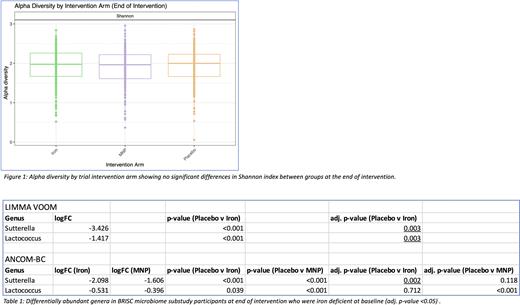Abstract
Children in low- and middle-income countries (LMICs) have a high burden of anemia, much of which is attributable to iron deficiency. The World Health Organization (WHO) recommends universal iron interventions in preschool-aged children in countries where there is a high anemia prevalence. However, oral iron supplementation is associated with increased risks of infection, including diarrhea. In small studies in Africa, iron has been shown to reprofile the intestinal microbiota leading to a reduction in commensal bacteria and an increase in pathogenic taxa. Gut dysbiosis has been implicated in the pathogenesis of gastrointestinal, autoimmune and inflammatory disease.
The BRISC (Benefits and Risks of Iron Interventions in Children) trial was a double-blind, placebo-controlled randomized controlled trial of oral iron supplementation in 3,300 infants in Bangladesh. Children were randomized to receive one of iron syrup, iron-containing multiple micronutrient powder (MNP) or placebo daily for three months. The primary outcome of the trial was child cognitive development. Key findings from the trial were an improvement in hematological indices with iron but no effect on the functional outcomes assessed (Pasricha et al New Engl J Med 2021).
We aimed to study the effect of iron on microbiome composition, diversity and function in the BRISC participants. To achieve this aim we undertook a substudy in which we collected stool samples from 925 children at the three time points of the main BRISC trial: at recruitment, end of intervention and at nine-month follow up. DNA was extracted and analyzed by 16S ribosomal RNA gene (rRNA) amplicon sequencing (2,339 samples across three timepoints) and shotgun metagenomics (965 samples across three timepoints). Episodes of infection were documented as per the main BRISC trial and included diarrhea, respiratory symptoms, antibiotic use, and clinic/hospital visits.
The V4 hypervariable region of the 16S rRNA gene was amplified and sequenced on the Illumina MiSeq instrument together with negative and positive controls. Demultiplexed forward and reverse FASTQ files for each sample were trimmed and processed using the DADA2 package in RStudio, and taxonomy was assigned using the SILVA 138 SSU Ref NR 99 reference database. Control samples and samples with fewer than 500 reads were removed (2,284 samples met this minimum read threshold). Taxonomic, alpha diversity and beta diversity measures were conducted using phyloseq and microbiomeSeq packages in RStudio. Differential abundance was calculated by two separate methods: i. limma voom (using trimmed mean of M values [TMM] normalization and log transformation) and ii. ANCOM-BC (using additive log-ratio transformation). Prior to implementing differential abundance methods a filter was applied such that operational taxonomic units (OTUs) found in under 10% of samples were pruned from the samples.
As previously reported, there was no overall significant increase in diarrhea incidence among participants receiving iron compared to those given placebo among BRISC trial participants.
Baseline iron deficiency, anemia and iron deficiency anemia prevalence among substudy participants was 33%, 42% and 26% respectively. 16S rRNA analysis demonstrated that recent antibiotic (12% of children at end of intervention) was associated with a significant reduction in alpha diversity. Accordingly, analysis was conducted to exclude recent antibiotic use from analysis by intervention arm. Using this analysis, there were no significant differences in alpha or beta diversity between trial intervention groups at the end of intervention (alpha diversity by Shannon index shown in Figure 1).
Members of Ruminococcus torques group (limma voom and ANCOM-BC) and Leuconostoc (limma voom only) were more abundant in the intestinal microbiota of children randomized to iron, but no genus was found to be differentially abundant when controlling for multiple comparisons. However, several bacterial genera were differentially abundant in children who were iron deficient at baseline who received iron. Two forms of analyses (Limma voom and ANCOM-BC) showed agreement in finding a reduction in Sutterella and Lactococcus species in iron deficient children receiving iron. These results are shown in Table 1.
These data indicate that reprofiling of the intestinal microbiota in response to iron supplementation is dependent on baseline host iron status.
Disclosures
Pasricha:Vifor Pharma: Consultancy; Keros Therapeutics: Consultancy.
Author notes
Asterisk with author names denotes non-ASH members.


This feature is available to Subscribers Only
Sign In or Create an Account Close Modal